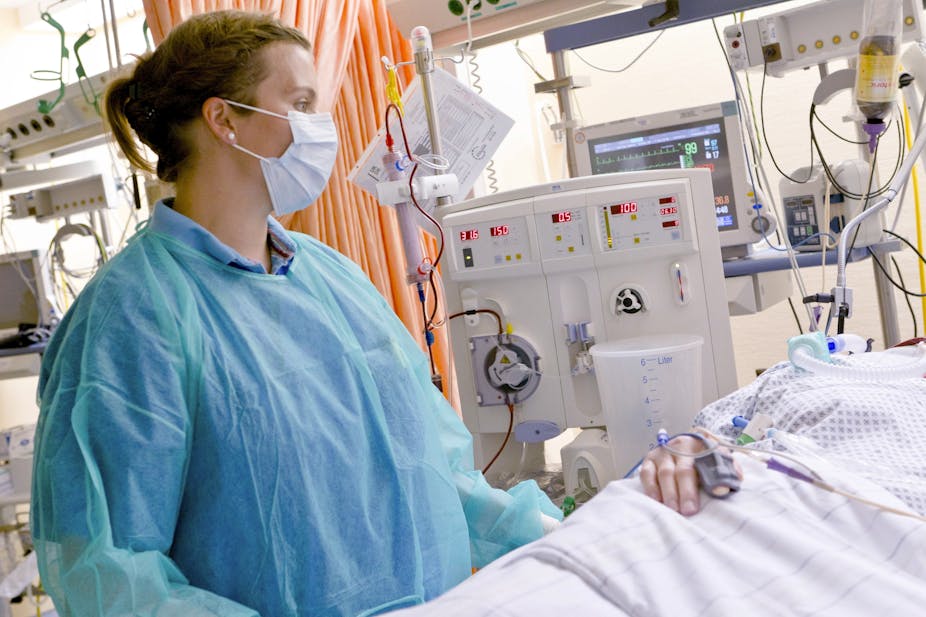Hospitals where nurses are qualified to bachelor’s degree level and have lower patient-to-nurse ratios have lower mortality rates.
In a cross-European study published in The Lancet, researchers found every 10% increase in the numbers of nurses with bachelor’s degrees at a hospital reduced patient mortality by 7%.
The researchers at the University of Pennsylvania School of Nursing and Catholic and the University of Leuven in Belgium also found that every one patient extra added to a nurse’s workload increased the likelihood of a person dying within 30 days by 7%.
“Nurses in hospitals are the surveillance system,” Linda Aiken, professor of nursing at the University of Pennsylvania and the lead author of the study, said. “If nurses’ work loads are too high, they don’t see patients early enough.”
She estimated that if nurses cared for no more than eight patients each, and 60% of them had bachelor’s degrees, hospital mortality following common surgery procedures could be reduced by a third.
The study used discharge data for 422,730 patients aged 50 years or older who had common surgery at 300 hospitals in nine European countries between 2007 and 2009. The research builds upon previous studies in the US and Canada.
Large variation between hospitals
A key finding was the large range of nurse staffing levels within countries. In England, there were an average of 8.8 patients to every nurse, across the 30 hospitals studied. But this varied from 5.5 in some hospitals, to 11.5 in others.
Of the nine countries in the study, Norway had the lowest patient-to-nursing-staff ratio at 5.2 patients per nurse, while Spain the highest, at 12.7.
But in both Spain and Norway all nurses are required to have batchelor’s degrees. At the time of the study, an average of 28% of English nurses surveyed had BAs, below the average of 52.1%. Again, this varied between nurses, from 10% in some hospitals, to 49% in others. However, since September 2013 it has been compulsory for all nurses in England to be educated to degree level.
The results bring into question a decision by the European Parliament in October 2013 to keep open two pathways into nursing. This retained a vocational pathway into nursing across Europe, which means nurses can begin training after only ten years of education in primary and secondary schools.
“No other part of the world accepts less than 12 [years],” Aiken said, adding that it could affect both patient outcomes and nurses’ ability to find work in other parts of the world.
Austerity bites
The research is published within a context of austerity across Europe, in which hospitals are looking to make savings across the board. “It’s very easy to just reduce nurses, because they’re a large proportion of expenses,” Aiken said, but she warned this would be a mistake.
Peter Griffiths, chair of health services research at the University of Southampton who was involved in the study, said that while the results don’t set out what is a safe level of staffing, “it makes it absolutely clear that low staffing levels are dangerous”.
Griffiths said even though a degree level education is now a requirement for nursing registration, there had been a “massive backlash” against it. “In the face of these figures it is hard to conclude that degree educated nurses are to blame for failings in the NHS. More likely, where nursing has failed it is because it has not been adequately resourced and supported by NHS managers in some hospitals.”
The researchers said that the study challenged the view that nursing experience was more important than education, but Cara Bailey, a lecturer in nursing at Birmingham University, said that “it has to be a combination of both.”
“Education and support are hugely important in developing caring, compassionate, competent, courageous and committed nurses,” she said.
“Care of patients who are critically ill is complex and patients can deteriorate rapidly. In today’s hospitals, patients are cared for in a variety of settings outside of critical care areas, so it is imperative that all nurses are provided with the educational support in order to notice cues around deterioration and act upon them appropriately and rapidly.”
“Reduced staffing is no doubt a major challenge but the problems hospital settings are faced with today requires a multifaceted approach that involves education, leadership and resources for support,” Bailey sad.
In England, the compulsory degree education for new nurses has raised concern about the number of nursing students needing placements in hospitals.
Karen Elcock, head of programmes for pre-registration nursing at Kingston University and St George’s, said recruitment on its new BSc Nursing Programme remains buoyant since its launch in September 2011.
However, she said, “The availability of practice placements has always been a challenge and continues to be so. Much of this is due to the significant reconfigurations that have taken place within the NHS.”
In response, St George’s has increased the amount of time students spend on community placements, and opened up new placement programmes with the independent and voluntary sector.
Bailey said that nursing education in England was carried out in partnership between universities and hospital trusts. “While there are some differences among entry requirements for programmes and the structure of curriculum delivery, half of the education programme is spent in practice working with clinical mentors caring for patients, and the other half within university, gaining the knowledge and critical awareness skills that underpin and support nursing practice.”

